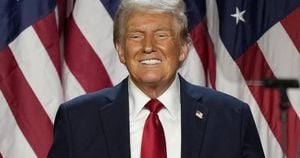Nuclear weapons have long loomed over global security, shaping international relations and military strategies. With the rise of new geopolitical tensions, particularly among the United States, Russia, and China, discussions about nuclear armament and disarmament have intensified. Various analysts and commentators are raising urgent concerns about the future of nuclear proliferation and its ramifications on world peace.
According to Eurasia Review, Robert S. Litwak's book Tripolar Instability: Nuclear Competition among the United States, Russia, and China provides an insightful analysis of how the nuclear dynamics have shifted from the bipolar era of the Cold War to a more complex tripolar competition. Litwak argues this new nuclear order introduces fresh challenges, disputing existing theories of nuclear deterrence and arms control.
Litwak's exploration begins with the historical backdrop of nuclear proliferation, highlighting how the USSR’s first atomic bomb detonation marked the start of nuclear rivalries. These tensions only escalated with China entering the scene, which has now been pushing for increased capabilities due to strategic pressures surrounding the South China Sea and Taiwan Straits.
Understanding this tripolar nuclear dynamic is more important than ever, especially with the forward momentum of technologies such as hypersonic weapons and missile defense systems. Litwak references the growing instability and arms race marked by unpredictable developments and challenges to established norms and treaties. The shift hints at the peril of miscalculation and inadvertent escalation globally.
Apart from scholarly analyses, the political stage is shifting as well. Under President Donald Trump, the United States saw significant withdrawals from multiple arms control agreements which had been the bedrock of stability for decades. According to various sources, Trump has surrounded himself with advisors known for their hawkish sentiments toward adversaries like Iran and China. This alignment has raised concerns about the possible deterioration of diplomatic resolutions and the risk of heightened conflict.
Reports suggest Trump’s new State Department team, including figures like Marco Rubio and Mike Waltz, points to intensified military confrontations rather than de-escalation. With his reinvigorated support for NATO's presence and demands for increased spending from allied nations, questions arise about the balance of global military power and nuclear threats.
For countries like Ukraine, the specter of nuclear weapons is becoming increasingly tangible. Recent papers from think tanks such as the Centre for Army, Conversion and Disarmament Studies (CACDS) indicate Ukraine could potentially develop nuclear capabilities independently if U.S. military aid were to cease. While Ukrainian officials have denied actively pursuing nuclear armament, the mere discussion reflects the escalated stakes at play amid the Russian invasion.
This situation was elaborated upon by Express, detailing how Ukraine might leverage its existing nuclear expertise and depleted uranium sources to construct weapons reminiscent of the bombs dropped on Nagasaki. The growth of nuclear discourse within Ukraine highlights the tearing fabric of diplomatic norms once regarded as sacrosanct. Experts warn against the catastrophic consequences of reintroducing nuclear arms to the Ukrainian-Russian conflict, which could usher significant global repercussions.
The importance of monitoring these tensions hasn’t fallen on deaf ears. The U.S. Air Force’s WC-135R Constant Phoenix aircraft, often dubbed “nuke sniffers,” plays a pivotal role by collecting nuclear debris during suspected tests and has been intertwined with global security monitoring. According to FLORIDA TODAY, these specially equipped planes help uphold the Limited Nuclear Test Ban Treaty of 1963, providing necessary data to track any nuclear developments, especially amid provocative actions taken by North Korea.
Historically, the WC-135R has been instrumental after significant nuclear events. Its surveillance over incidents like the Chernobyl disaster and North Korea's nuclear tests exemplifies the tangible efforts made to maintain oversight on nuclear capabilities worldwide. Such initiatives remain pivotal as the U.S. navigates its role amid rising nuclear concerns between China and Russia.
Against this multifaceted geopolitical backdrop, peace organizations have raised alarms about the interconnectedness of nuclear policies, climate change, and militarism. Groups like the Campaign for Nuclear Disarmament (CND) echo sentiments of heightened vigilance against the rise of nuclear arms, warning against militaristic agendas driving global policies. The CND actively advocates for global nuclear disarmament to avert cataclysmic scenarios, pointing out the need for diplomatic solutions over military posturing.
Analysts have delivered stark warnings about the consequences of the tripolar nuclear model potentially leading to catastrophic conflicts akin to the Cold War era. With tensions simmering globally and leaders espousing aggressive doctrines, the implication of nuclear stakes has become ever more pronounced. Threats of escalation are not just confined to battlefield talk; they ripple through global channels, signing off on alarming possibilities.
To navigate these complex waters, leaders and policy-makers are urged to pursue innovative arms control frameworks and diplomatic dialogues. Renewed discussions could open up necessary channels for crisis communications to mitigate the risks of inadvertent escalation as the world grapples with tough strategic landscapes.
The notion of nuclear security now occupies a precarious balance, urging nations to reconsider their stances, whether it be disarmament or defence, as the global environment shifts. The engagement of countries like the United States, Russia, and China remains pivotal to determining whether the future will be defined by peace or fear of annihilation.
Speculations continue about how the policies of new administrations will shape these dynamics. What remains evident is the call for extensive dialogue, collaboration, and the embracing of new diplomatic avenues to quell fears as humanity navigates through this perilous territory—one where nuclear power lurks closely.



